 I have a view controller which allows a user to take a picture. I am setting the avcapture bounds to be the bounds of a view on screen.
I have a view controller which allows a user to take a picture. I am setting the avcapture bounds to be the bounds of a view on screen.
Above this view I have a collection view. So users can capture multiple pictures, they are then added to the collection view above.
I am having trouble with the correct orientation appearing in my preview above.
Code is as follows:
@IBOutlet weak var imagePreviews: UICollectionView!
@IBOutlet weak var imgPreview: UIView!
var session: AVCaptureSession?
var stillImageOutput: AVCaptureStillImageOutput?
var videoPreviewLayer: AVCaptureVideoPreviewLayer?
var images: [UIImage] = [UIImage]()
var isLandscapeLeft : Bool = false
var isLandscapeRight : Bool = false
var isPortrait : Bool = false
var isPortraitUpsideDown: Bool = false
@IBAction func capture(_ sender: UIButton)
{
if let videoConnection = stillImageOutput?.connection(withMediaType: AVMediaTypeVideo)
{
stillImageOutput?.captureStillImageAsynchronously(from: videoConnection, completionHandler: { (sampleBuffer, error) in
if sampleBuffer != nil {
if let imageData = AVCaptureStillImageOutput.jpegStillImageNSDataRepresentation(sampleBuffer), let dataProvider = CGDataProvider(data: imageData as CFData), let cgImageRef = CGImage(jpegDataProviderSource: dataProvider, decode: nil, shouldInterpolate: true, intent: CGColorRenderingIntent.defaultIntent)
{
var image: UIImage
if (self.isLandscapeLeft || self.isLandscapeRight)
{
image = UIImage(cgImage: cgImageRef, scale: 1.0, orientation: self.isLandscapeLeft ? UIImageOrientation.left : UIImageOrientation.right)
} else {
image = UIImage(cgImage: cgImageRef, scale: 1.0, orientation: self.isPortrait ? UIImageOrientation.up : UIImageOrientation.down)
}
image = self.fixOrientation(img: image)
self.images.append(image)
DispatchQueue.main.async {
self.imagePreviews.reloadData()
}
}
}
})
}
}
}
override func viewDidLayoutSubviews() {
super.viewDidLayoutSubviews()
if let connection = self.videoPreviewLayer?.connection {
let currentDevice: UIDevice = UIDevice.current
let orientation: UIDeviceOrientation = currentDevice.orientation
let previewLayerConnection : AVCaptureConnection = connection
if (previewLayerConnection.isVideoOrientationSupported) {
switch (orientation) {
case .portrait:
isLandscapeLeft = false
isLandscapeRight = false
isPortrait = true
isPortraitUpsideDown = false
updatePreviewLayer(layer: previewLayerConnection, orientation: .portrait)
break
case .landscapeRight:
isLandscapeLeft = false
isLandscapeRight = true
isPortrait = false
isPortraitUpsideDown = false
updatePreviewLayer(layer: previewLayerConnection, orientation: .landscapeRight)
break
case .landscapeLeft:
isLandscapeLeft = true
isLandscapeRight = false
isPortrait = false
isPortraitUpsideDown = false
updatePreviewLayer(layer: previewLayerConnection, orientation: .landscapeLeft)
break
case .portraitUpsideDown:
isLandscapeLeft = false
isLandscapeRight = false
isPortrait = false
isPortraitUpsideDown = true
updatePreviewLayer(layer: previewLayerConnection, orientation: .portraitUpsideDown)
break
default:
updatePreviewLayer(layer: previewLayerConnection, orientation: .portrait)
break
}
}
}
}
func fixOrientation(img: UIImage) -> UIImage {
if (img.imageOrientation == .up) {
return img
}
UIGraphicsBeginImageContextWithOptions(img.size, false, img.scale)
let rect = CGRect(x: 0, y: 0, width: img.size.width, height: img.size.height)
img.draw(in: rect)
let normalizedImage = UIGraphicsGetImageFromCurrentImageContext()!
UIGraphicsEndImageContext()
return normalizedImage
}